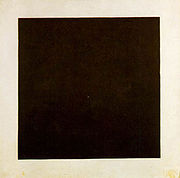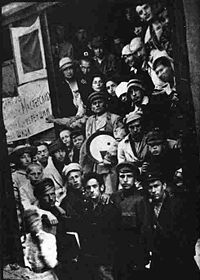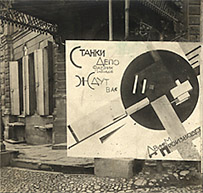
UNOVIS
Encyclopedia

Russia
Russia or , officially known as both Russia and the Russian Federation , is a country in northern Eurasia. It is a federal semi-presidential republic, comprising 83 federal subjects...
n artists, founded and led by Kazimir Malevich
Kazimir Malevich
Kazimir Severinovich Malevich was a Russian painter and art theoretician, born of ethnic Polish parents. He was a pioneer of geometric abstract art and the originator of the Avant-garde Suprematist movement.-Early life:...
at the Vitebsk Art School in 1919.
Initially formed by students and known as MOLPOSNOVIS, the group formed to explore and develop new theories and concepts in art. Under the leadership of Malevich they renamed to UNOVIS, chiefly focusing on his ideas on Suprematism
Suprematism
Suprematism was an art movement focused on fundamental geometric forms which formed in Russia in 1915-1916. It was not until later that suprematism received conventional museum preparations...
and producing a number of projects and publications whose influence on the avant-garde in Russia
Russian avant-garde
The Russian avant-garde is an umbrella term used to define the large, influential wave of modern art that flourished in Russia approximately 1890 to 1930 - although some place its beginning as early as 1850 and its end as late as 1960...
and abroad was immediate and far-reaching. The group disbanded in 1922.
The name UNOVIS is an abbreviation
Abbreviation
An abbreviation is a shortened form of a word or phrase. Usually, but not always, it consists of a letter or group of letters taken from the word or phrase...
in Russian
Russian language
Russian is a Slavic language used primarily in Russia, Belarus, Uzbekistan, Kazakhstan, Tajikistan and Kyrgyzstan. It is an unofficial but widely spoken language in Ukraine, Moldova, Latvia, Turkmenistan and Estonia and, to a lesser extent, the other countries that were once constituent republics...
of "Utverditeli Novogo Iskusstva" or "The Champions of the New Art" , while POSNOVIS was an abbreviation of "Posledovateli Novogo Iskusstva" or "Followers of the New Art", and MOLPOSNOVIS meant "Young Followers of the New Art."
Foundation and growth

Multimedia
Multimedia is media and content that uses a combination of different content forms. The term can be used as a noun or as an adjective describing a medium as having multiple content forms. The term is used in contrast to media which use only rudimentary computer display such as text-only, or...
available at the time. In January 1920, Malevich was invited to teach at the school in 1919 by Marc Chagall
Marc Chagall
Marc Chagall Art critic Robert Hughes referred to Chagall as "the quintessential Jewish artist of the twentieth century."According to art historian Michael J...
and immediately appointed by the director of the school at the time, Vera Yermolayeva, to head a teaching studio. In February of the same year, under the leadership of Malevich, the group worked on a "Suprematist ballet", choreographed by Nina Kogan, and the precursor to Aleksander Kruchenykh's influential futurist
Futurism (art)
Futurism was an artistic and social movement that originated in Italy in the early 20th century. It emphasized and glorified themes associated with contemporary concepts of the future, including speed, technology, youth and violence, and objects such as the car, the airplane and the industrial city...
opera, Victory Over the Sun
Victory over the Sun
Victory over the Sun is a Russian Futurist opera premiered in 1913 at the Luna Park in Saint Petersburg.The libretto written in zaum language was contributed by Aleksei Kruchonykh, the music was written by Mikhail Matyushin, the prologue was added by Velimir Khlebnikov, and the stage designer was...
. Following the production, POSNOVIS underwent more changes and was renamed UNOVIS on February 14, 1920.
Expansion and influence
In early 1920, Marc Chagall selected Malevich to succeed him as director. Malevich accepted and radically reorganized not only UNOVIS but the entire school's curriculum. He transformed UNOVIS into a highly structured organization, forming the UNOVIS Council. Meanwhile the group's theories and styles were rapidly evolving at the hands of Malevich and his star students and colleagues, including notable Russian artists El LissitzkyEl Lissitzky
, better known as El Lissitzky , was a Russian artist, designer, photographer, typographer, polemicist and architect. He was an important figure of the Russian avant garde, helping develop suprematism with his mentor, Kazimir Malevich, and designing numerous exhibition displays and propaganda works...
, Nikolai Suetin
Nikolai Suetin
Nikolai Suetin was a Russian Suprematist artist. He worked as a graphic artist, a designer, and a ceramics painter.Suetin studied at the High Institute of Art, Vitebsk under Kazimir Malevich, founder of Suprematism, an early abstract art movement which developed a style based on 'non objective'...
, Ilia Chashnik, Vera Ermolaeva, Anna Kagan, and Lev Yudin, amongst others. The group's objective was now to introduce Suprematist
Suprematism
Suprematism was an art movement focused on fundamental geometric forms which formed in Russia in 1915-1916. It was not until later that suprematism received conventional museum preparations...
designs and ideals to Russian society, working with and for the Soviet government:

Embracing the Communist ideal, the group chose to share credit and responsibility for all works produced. They signed all works with a solitary black square, a homage
Homage
Homage is a show or demonstration of respect or dedication to someone or something, sometimes by simple declaration but often by some more oblique reference, artistic or poetic....
to a previous artwork by Malevich. This would become the de facto seal
Seal (device)
A seal can be a figure impressed in wax, clay, or some other medium, or embossed on paper, with the purpose of authenticating a document ; but the term can also mean the device for making such impressions, being essentially a mould with the mirror image of the design carved in sunken- relief or...
of UNOVIS and took the place of individual names or initials.
In June 1920 UNOVIS's ambitions accelerated, culminating in a print collection of UNOVIS philosophies and theories and participation in the "First All-Russian Conference of Teachers and Students of Arts," which took place in Moscow
Moscow
Moscow is the capital, the most populous city, and the most populous federal subject of Russia. The city is a major political, economic, cultural, scientific, religious, financial, educational, and transportation centre of Russia and the continent...
. UNOVIS students who made the trip from Vitebsk to Moscow rapidly distributed artworks, newsletters, manifestos, fliers, and copies of Malevich's "On New Systems in Art" and copies of the "UNOVIS Almanac." UNOVIS succeeded in achieving recognition and became respected as an established and influential movement.

